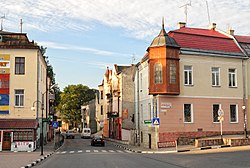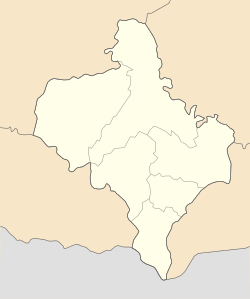Rohatyn
Rohatyn
Рогатин | |
|---|---|
 Roksolany Square | |
| Coordinates: 49°25′N 24°37′E / 49.417°N 24.617°E | |
| Country | |
| Oblast | Ivano-Frankivsk Oblast |
| Raion | Ivano-Frankivsk Raion |
| Hromada | Rohatyn urban hromada |
| Founded | 12th century |
| Population (2022) | |
• Total | 7,521 |
| Website | www.rohatyn.ronet.com.ua |
Rohatyn (Ukrainian: Рогатин, IPA: [roɦɐˈtɪn] ⓘ; Polish: Rohatyn) is a city located on the Hnyla Lypa River in Ivano-Frankivsk Raion, Ivano-Frankivsk Oblast, in western Ukraine. It hosts the administration of Rohatyn urban hromada, one of the hromadas of Ukraine.[1] Population: 7,521 (2022 estimate).[2]
Name
[edit]It was first mentioned in historical documents in 1184 as a part of the Kingdom of Galicia–Volhynia. Its name seems to be derived from Ruthenia, the name of the region of the location. However, the town emblem has a horn of a deer which gives the first part of the Slavic name of Rohatyn or Rogatyn – "Rog" ("Horn"). The second part "Tyn" can be connected with a word which means "Stacket". Together these two words give us "Horn Stacket".
Also, there is a legend connected with the image of the deer horn of the town emblem. It is said that a wife of the Duke Jaroslav Osmomysl, being lost in a forest, met a deer. She survived by following the deer out of the forest. A fort was built with name "Rogach" ("Deer") on the place where the duchess supposedly stepped out of the forest.
The town name also can be connected with the Slavic word "Rogatyna" which means a heavy spear for martial arts or bear hunting ("Bear Spear"). It was first mentioned in 1149 (Laurentian Chronicle). In Polish heraldry "Rogacina" means "Broadhead".[citation needed]
History
[edit]
In 1415, under Polish rule, it was granted Magdeburg rights, and subsequently developed into an important trading and manufacturing town. In 1520, the region was attacked by Crimean Tatars, Nastia Lisovska (Roksolana or Hürrem Sultan), a native of Rohatyn, was captured there and sold to the Ottoman Sultan Suleiman the Magnificent of which she became his concubine, then his legal wife and haseki sultan. In the 16th century a renowned school of icon painting arose in Rohatyn, and in the 1580s an Orthodox brotherhood was founded obtaining the stauropegion (a monastery exempt from the control of the local bishop) status. After the First Partition of Poland in 1772, Rohatyn was annexed by Austria, and became a county center. A Ukrainian gymnasium was established there in 1909, and a minor theological seminary in 1931. In 1910, half of the town population was Jewish. During the interwar period the town was under Polish rule.
| Year | Pop. | ±% |
|---|---|---|
| 1921 | 5,736 | — |
| 1931 | 7,513 | +31.0% |
| 2022 | 7,521 | +0.1% |
| Source: [3] | ||
Following the joint German-Soviet invasion of Poland, which started World War II in September 1939, the village was occupied by the Soviet Union until 1941, then by Germany until 1944, and re-occupied by the Soviet Union, which annexed it from Poland in 1945. In 1939, it became part of Soviet Ukraine and was granted city status. During the war, 99 percent of the 3,000 strong Jewish population were murdered in The Holocaust.[citation needed]
Today it is an important highway junction; 26 percent of its inhabitants work in the transportation industry.
Until 18 July 2020, Rohatyn was the administrative center of Rohatyn Raion. The raion was abolished in July 2020 as part of the administrative reform of Ukraine, which reduced the number of raions of Ivano-Frankivsk Oblast to six. The area of Rohatyn Raion was merged into Ivano-Frankivsk Raion.[4][5]
The Books of Jacob, Nobel winner Olga Tokarczuk's magnum opus, begins in Rohatyn.[6]
Monuments
[edit]- stone Church of the Nativity of the Theotokos (end of the 14th century)
- remnants of the town walls and gate from the 13th and 14th centuries
- wooden Church of the Holy Spirit (1644–1645) with a magnificent iconostasis (1647–1650) is on UNESCO world heritage list
- the ruins of the Dominican monastery (1614)
- Roman Catholic Saint Nicholas's Church in the Renaissance style (1666)
- wooden Saint Nicholas's Church (1729).
- Statue of Nastia Lisovska (Hürrem Sultan) (1999) replacement for a statue of Lenin
Notable people
[edit]- Hürrem Sultan (Roxelana), consort to Suleiman the Magnificent, first Haseki Sultan of the Ottoman Empire and initiator of the Sultanate of Women
- Lessia Leskiv, a Ukrainian sport shooter
- Ivan Krypiakevych, a Ukrainian historian, academician, professor of Lviv University and director of the Institute of Social Sciences of Ukraine, worked in Rohatyn.
- Sylvia Lederman, Holocaust survivor
Gallery
[edit]-
Nativity of Blessed Virgin Mary Ukrainian Catholic Church
-
Holy Spirit Church
-
Catholic Saint Nicholas's Church
-
Church of Saint Nicholas
-
Jewish musicians from Rohatyn, 1912
Location
[edit]- Local orientation
- Regional orientation
Notes
[edit]
References
[edit]- ^ "Рогатинская городская громада" (in Russian). Портал об'єднаних громад України.
- ^ Чисельність наявного населення України на 1 січня 2022 [Number of Present Population of Ukraine, as of January 1, 2022] (PDF) (in Ukrainian and English). Kyiv: State Statistics Service of Ukraine. Archived (PDF) from the original on 4 July 2022.
- ^ Wiadomości Statystyczne Głównego Urzędu Statystycznego (in Polish). Vol. X. Warszawa: Główny Urząd Statystyczny. 1932. p. 195.
- ^ "Про утворення та ліквідацію районів. Постанова Верховної Ради України № 807-ІХ". Голос України (in Ukrainian). 2020-07-18. Retrieved 2020-10-03.
- ^ "Нові райони: карти + склад" (in Ukrainian). Міністерство розвитку громад та територій України.
- ^ Tokarczuk, Olga (Jan 31, 2023). The Books of Jacob. Translated by Croft, Jennifer. Penguin Random House. ISBN 9780593087503.
{{cite book}}: CS1 maint: date and year (link)
External links
[edit]- Rohatyn in the Encyclopedia of Ukraine
- Website of Rohatyn
- Jewish Rohatyn
- Photographs of Jewish sites in Rohatyn in Jewish History in Galicia and Bukovina
- Site about Rohatyn with photos and history
- Rohatyn District Research Group
- Rohatyn Jewish Heritage
- Gesher Galicia - A group dedicated to the Jewish genealogy of Galicia and preserving its Jewish culture and heritage









